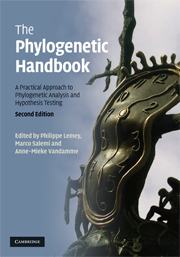Book contents
- Frontmatter
- Contents
- List of contributors
- Foreword
- Preface
- Section I Introduction
- Section II Data preparation
- Section III Phylogenetic inference
- 4 Genetic distances and nucleotide substitution models
- 5 Phylogenetic inference based on distance methods
- 6 Phylogenetic inference using maximum likelihood methods
- 7 Bayesian phylogenetic analysis using MRBAYES
- 8 Phylogeny inference based on parsimony and other methods using PAUP
- 9 Phylogenetic analysis using protein sequences
- Section IV Testing models and trees
- Section V Molecular adaptation
- Section VI Recombination
- Section VII Population genetics
- Section VIII Additional topics
- Glossary
- References
- Index
8 - Phylogeny inference based on parsimony and other methods using PAUP
from Section III - Phylogenetic inference
Published online by Cambridge University Press: 05 June 2012
- Frontmatter
- Contents
- List of contributors
- Foreword
- Preface
- Section I Introduction
- Section II Data preparation
- Section III Phylogenetic inference
- 4 Genetic distances and nucleotide substitution models
- 5 Phylogenetic inference based on distance methods
- 6 Phylogenetic inference using maximum likelihood methods
- 7 Bayesian phylogenetic analysis using MRBAYES
- 8 Phylogeny inference based on parsimony and other methods using PAUP
- 9 Phylogenetic analysis using protein sequences
- Section IV Testing models and trees
- Section V Molecular adaptation
- Section VI Recombination
- Section VII Population genetics
- Section VIII Additional topics
- Glossary
- References
- Index
Summary
THEORY
Introduction
Methods for inferring evolutionary trees can be divided into two broad categories: those that operate on a matrix of discrete characters that assigns one or more attributes or character states to each taxon (i.e. sequence or gene-family member); and those that operate on a matrix of pairwise distances between taxa, with each distance representing an estimate of the amount of divergence between two taxa since they last shared a common ancestor (see Chapter 1). The most commonly employed discrete-character methods used in molecular phylogenetics are parsimony and maximum likelihood methods. For molecular data, the character-state matrix is typically an aligned set of DNA or protein sequences, in which the states are the nucleotides A, C, G, and T (i.e. DNA sequences) or symbols representing the 20 common amino acids (i.e. protein sequences); however, other forms of discrete data such as restriction-site presence/absence and gene-order information also may be used.
Parsimony, maximum likelihood, and some distance methods are examples of a broader class of phylogenetic methods that rely on the use of optimality criteria. Methods in this class all operate by explicitly defining an objective function that returns a score for any input tree topology. This tree score thus allows any two or more trees to be ranked according to the chosen optimality criterion. Ordinarily, phylogenetic inference under criterion-based methods couples the selection of a suitable optimality criterion with a search for an optimal tree topology under that criterion.
- Type
- Chapter
- Information
- The Phylogenetic HandbookA Practical Approach to Phylogenetic Analysis and Hypothesis Testing, pp. 267 - 312Publisher: Cambridge University PressPrint publication year: 2009
- 32
- Cited by

